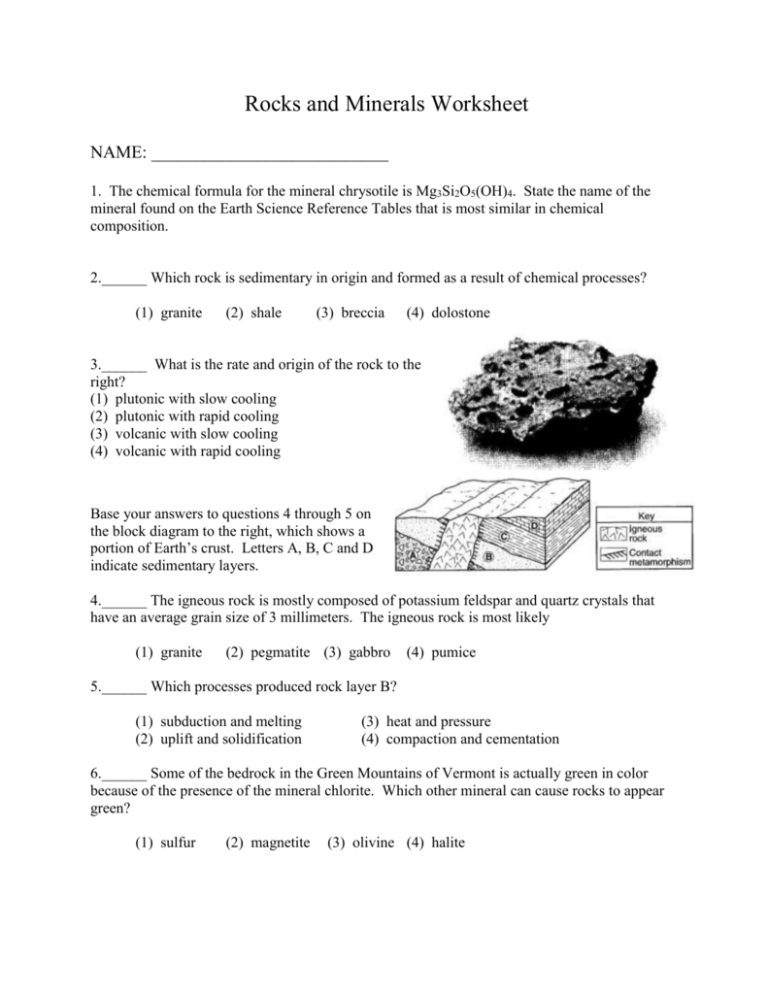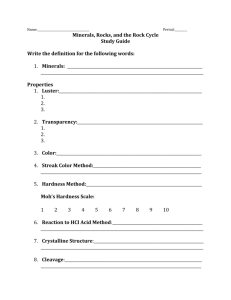Review Worksheet On Rocks And Minerals
advertisement

Rocks and Minerals Worksheet NAME: ___________________________ 1. The chemical formula for the mineral chrysotile is Mg3Si2O5(OH)4. State the name of the mineral found on the Earth Science Reference Tables that is most similar in chemical composition. 2.______ Which rock is sedimentary in origin and formed as a result of chemical processes? (1) granite (2) shale (3) breccia (4) dolostone 3.______ What is the rate and origin of the rock to the right? (1) plutonic with slow cooling (2) plutonic with rapid cooling (3) volcanic with slow cooling (4) volcanic with rapid cooling Base your answers to questions 4 through 5 on the block diagram to the right, which shows a portion of Earth’s crust. Letters A, B, C and D indicate sedimentary layers. 4.______ The igneous rock is mostly composed of potassium feldspar and quartz crystals that have an average grain size of 3 millimeters. The igneous rock is most likely (1) granite (2) pegmatite (3) gabbro (4) pumice 5.______ Which processes produced rock layer B? (1) subduction and melting (2) uplift and solidification (3) heat and pressure (4) compaction and cementation 6.______ Some of the bedrock in the Green Mountains of Vermont is actually green in color because of the presence of the mineral chlorite. Which other mineral can cause rocks to appear green? (1) sulfur (2) magnetite (3) olivine (4) halite 7.______ Which state is best supported by the diagram? (1) (2) (3) (4) A fingernail will scratch calcite, but not gypsum. Calcite will be scratched by a copper penny. The mineral apatite will scratch topaz. A steel file has a hardness of about 7.5. 8.______ What processes form granite? (1) (2) (3) (4) compaction and cementation of sediments cooling and solidification of magma uplift and weathering of bedrock application of heart and pressure to shale Base your answers to questions 9 through 12 on the map to the right and the passage below. The map shows the outlines and the ages of several calderas created as a result of volcanic activity over the last 16 million years as the North American Plate moved over the Yellowstone Hot Spot. A and B represent locations within the calderas. The Yellowstone Hot Spot has interacted with the North American Plate, causing widespread outpourings of basalt. Some of the basaltic magma produced by the hot spot accumulates near the base of the plate, where it melts the crust above. The melted crust, in turn, rises closer to the surface to form large reservoirs of potentially explosive rhyolite magma. Catastrophic eruptions have partly emptied some of these reservoirs, causing their roofs to collapse. The resulting craters are known as volcanic calderas. 9. Describe the texture of the basalt produced in the Yellowstone Hot Spot. 10. Identify two minerals found in the igneous rock that is produced from the explosive rhyolite magma. 11. Based on the age pattern of the calderas shown on the map, in which compass direction has the North American Plate moved during the last 16 million years? 12. Calculate, in miles per million years, the rate at which the North American Plate has moved over the Yellowstone Hot Spot between point A and point B. 13.______ Which group of elements is listed in increasing order based on the percent by mass in Earth’s crust? (1) aluminum, iron, calcium (2) aluminum, silicon, magnesium (3) magnesium, iron, aluminum (4) magnesium, silicon, calcium 13.______ Which characteristic of the granite intrusion provides the most direct evidence that it solidified deep underground? (1) very hard (2) coarse texture (3) light color (4) felsic composition 14.______ Which rock most probably formed in the contact metamorphic zone with rock unit 6? (1) marble (2) basalt (3) quartzite (4) hornfels Use the map to the right to answer questions 15 and 16. 15. Identify one New York State landscape region in which deposits of gypsum and halite are commonly found. 16. Identify the sedimentary rock composed of halite and explain how this rock is usually formed. Base your answers to questions 17 and 18 on the diagram to the right of a mineral classification scheme that shows the properties of certain minerals. Letters A through G represent mineral property zones. Zone E represents the presence of all three properties. For example, a mineral that is harder than glass, has a mineral luster, but does not have cleavage, would be placed in zone B. Assume that glass has a hardness of 5.5. 17. In which zone would the mineral potassium feldspar be placed? 18. State the name of one mineral listed on the Properties of Common Mineral Table that could not be placed in any one of the zones. 19. State the name of the dominant sediment particle that is compacted to form the rock shale. 20.______ Which process led to the formation of thick salt deposits found in the bedrock at some locations in New York State? (1) melting (2) runoff (3) condensation (4) evaporation 21.______ Oxygen is the most abundant element by volume in Earth’s (1) inner core (2) troposphere (3) hydrosphere (4) crust 22.______ In which type of rock would fossils of organisms most likely be found? (1) felsic igneous (2) vesicular igneous (3) clastic sedimentary (4) nonfoliated metamorphic The diagram to the right represents geological processes that act continuously on Earth to form different rock types. 23.______ Which table below correctly classifies each rock type? The table to the right shows some properties of four different minerals. 24. The minerals listed in the table to the right are varieties of which mineral? (1) garnet (2) magnetite (3) quartz (4) olivine 25.______ What two minerals are most likely found in beach sand that was eroded from headlands composed of the rock diorite? (1) quartz and olivine (2) plagioclase feldspar and amphibole (3) potassium feldspar and biotite (4) pyroxene and calcite 26.______ What determines the physical properties of minerals, such as the long, stiff fibers of some varieties of asbestos? 27.______ Which type of rock most likely contains fossils? (1) scoria (2) gabbro (3) schist (4) shale 28.______ In which New York State landscape region is most of the surface bedrock composed of metamorphic rocks? (1) Adirondacks (2) Catskills (3) Erie-Ontario Lowlands (4) Newark Lowlands 29.______ A human fingernail has a hardness of approximately 2.5. Which two minerals are softer than a human fingernail? (1) calcite and halite (2) sulfur and fluorite (3) graphite and talc (4) pyrite and magnetite 30.______ Which physical characteristic best describes the rock phyllite? (1) glassy texture with gas pockets (2) clastic texture with angular fragments (3) bioclastic texture with cemented shell fragment (4) foliated texture with microscopic mice crystals 31.______ Which home-building material is made mostly from the mineral gypsum? (1) plastic pipes (2) window glass (3) drywall panels (4) iron nails 32.______ The two most abundant elements by mass in Earth’s crust are oxygen and (1) potassium (2) hydrogen (3) nitrogen The diagram to the right represents a part of the crystal structure of the mineral kaolinite. 33.______ An arrangement of atoms such as the one shown in the diagram represents a mineral’s (1) (2) (3) (4) age of formation infiltration rate physical properties temperature of formation (4) silicon Base your answers to questions 24 through 36 on the diagram and table to the right. The diagram represents a felsic igneous rock. Letters A, B and C represent three different minerals in the rock sample. The table describes the physical properties of minerals A, B and C found in the igneous rock sample. 34. State the texture of this igneous rock. 35. On the table provided to the right, state the names of minerals A, B and C. 36. State two processes responsible for the formation of an igneous rock. The pie graph to the right shows the elements comprising Earth’s crust in percent by mass. 37.______ Which element is represented by the letter X? (1) silicon (2) lead (3) nitrogen (4) hydrogen 38. State one physical property of garnets, other than color, which make them useful as gemstones.





